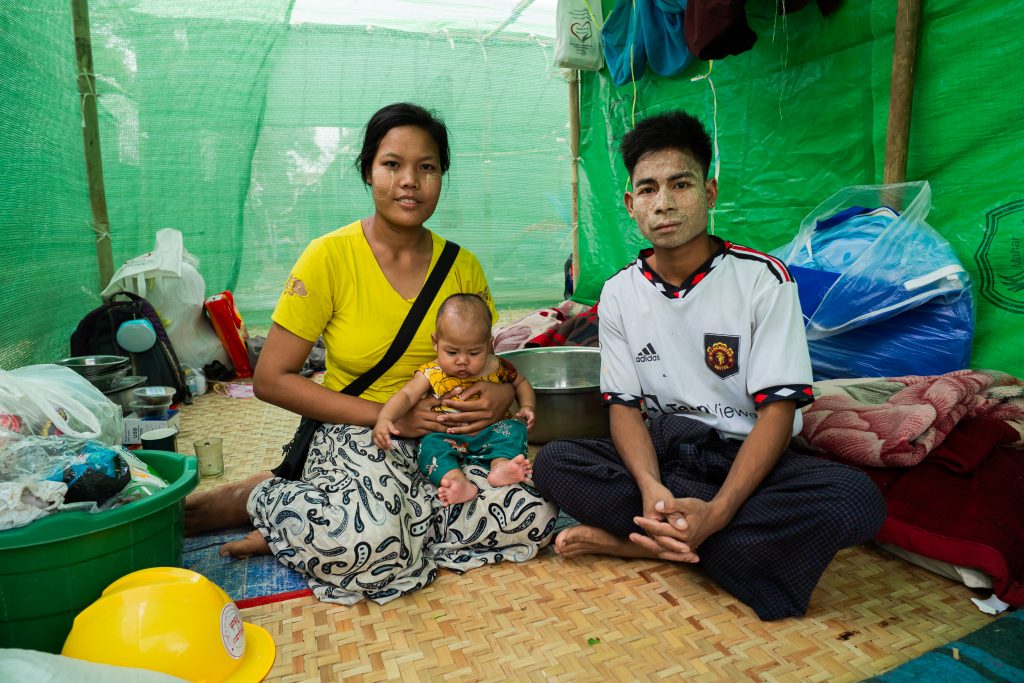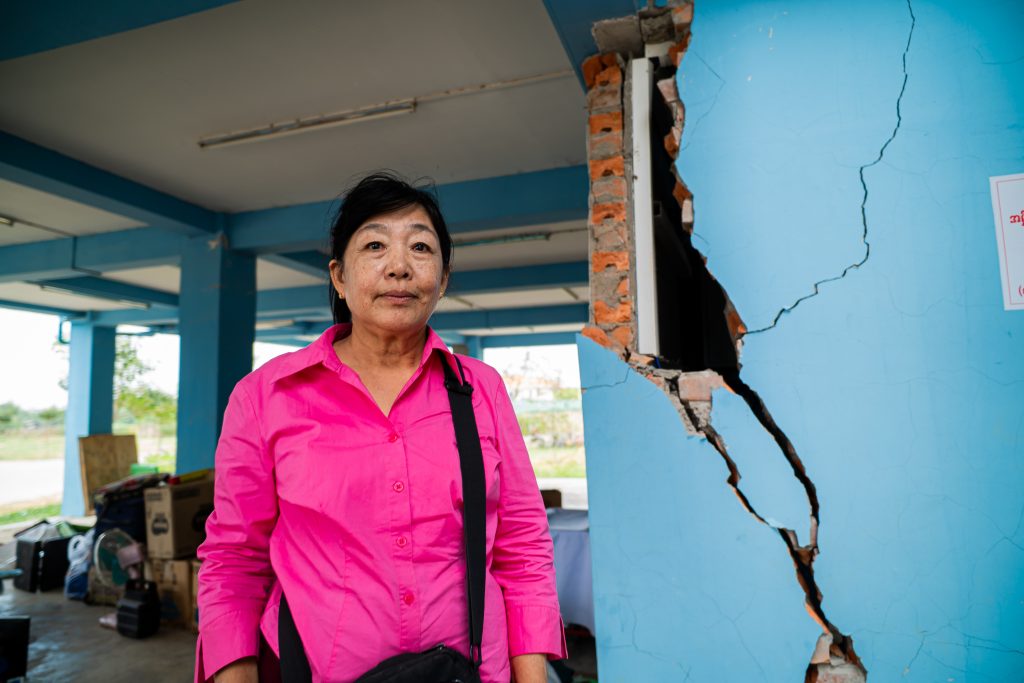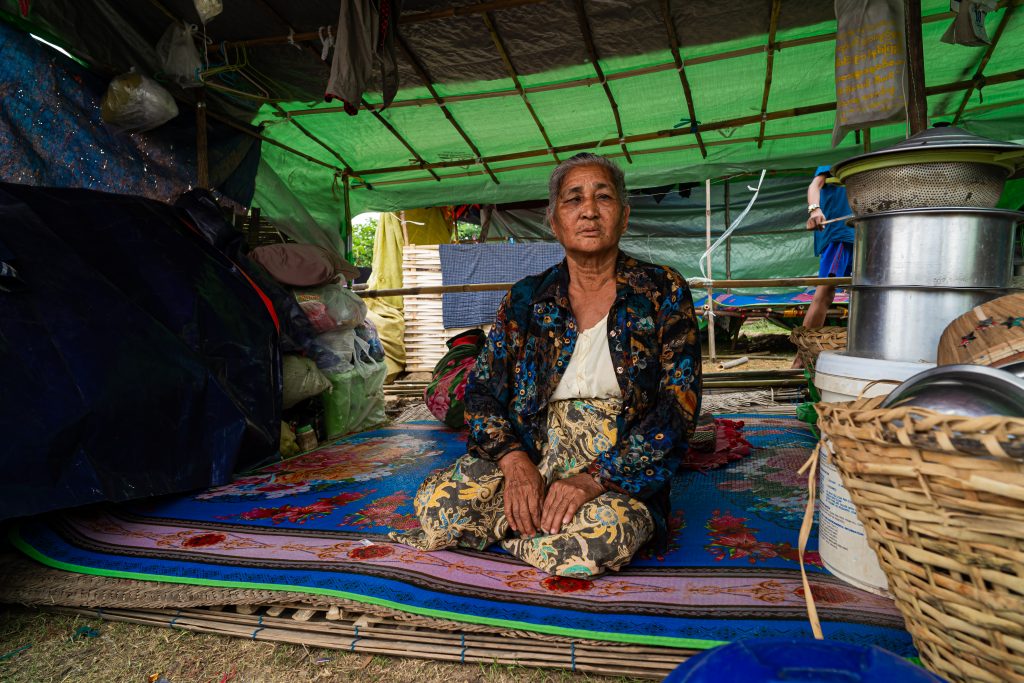‘My biggest worry is my baby will get sick from the rain’
Survivors of the earthquake in Myanmar talk about their experiences of living in temporary shelter in Mandalay, the quake’s epicentre.
PEOPLE IN MYANMAR are living in harsh conditions following the severe earthquake on March 28, which claimed at least 5352 lives.
The quake’s epicentre was near Mandalay, Myanmar’s second largest city. Many people were already living as displaced people in Mandalay, due to conflict in the country.
Three women now living in temporary shelter in Mandalay tell us their experiences of surviving in amongst the ruins.
Ma Ei Ei Mon hopes her five month old baby won’t get sick

Ma Ei Ei Mon, 25, lived in a village with her five-month-old daughter and her husband, Zin Ko Maung, in Kyaung Shar Village, located in Amarapura Township, Mandalay.
On March 28, when the powerful 7.7 magnitude earthquake struck the region, Kyaung Shar Village was one of the hardest-hit areas.
“My house was badly damaged during the earthquake, and it’s not safe to stay inside anymore. The roof has caved in, and it can’t protect us from the rain. That’s why we moved to this temporary camp,” she said.
Together with her husband and daughter, she sought shelter in a nearby temporary camp, along with many other displaced families. But the challenges didn’t end with losing their home.
Since the earthquake, her husband hasn’t been able to return to work. As a local painter his income of 13,000 Myanmar Kyat (about 5.70 euros) per day was their only means of survival. Now he has no work. With no money for food, medicine, or baby supplies, the family were in a terrible situation.
“In the past, we lived only on my husband’s income. It wasn’t much, but we survived. Now, he can’t work, and I’m starting to worry. What if we don’t have enough for food or medicine for our baby,” she asks.
Her greatest concern was her daughter. At just five months old, the baby was vulnerable especially in the temporary shelter that offered little protection from the elements. With a storm approaching, Ma Ei Ei Mon feared for her child’s health.
“Even though many people came and donated clothes and medicine, especially for my baby, we still need more help. My biggest worry is that she will get sick from the rain.”
Daw Cho Cho Tint can’t find a place to live

After decades spent in the quiet hills of Kaw Lin, Daw Cho Cho Tint’s life changed overnight. The violence of the conflict forced her to flee her hometown. Alone and displaced, she found temporary safety in a government apartment in Patheingyi Township, Mandalay.
“It was just about a year since I fled to Mandalay. I was slowly getting used to my new life. Then the earthquake hit.”
In seconds, the building that had become her new home was left cracked and crumbling, declared unsafe by authorities. Forced out of her apartment, she now lives under a temporary shelter near the ruins with other families.
“It was a nightmare and I don’t want to describe it. Now I am living in a temporary shelter and my life is not as easy as it used to be. Although many donors come and donate food and water, I have to queue very long to get the supplies. As I become older, those things are not easy for me anymore,” she shared.
The tough conditions of displacement have become more difficult with each passing day. Shelter from rain is barely sufficient, and rental prices in the area have soared following the disaster.
“I have no idea where to stay now. The rental rate is getting higher too. Even the small apartments are asking 200,000 Myanmar Kyat (around 87 euros) with at least a three-month contract. I have to pay 600,000 Myanmar Kyat (around 252 euros) in total and I’m having so much difficulty with that,” she said emotionally.
With the rainy season approaching, every night brings new fear. “Last night, there was a big rainstorm. I had to hold my shelter not to be thrown away by the wind. I couldn’t sleep the whole night. I am also worried that it will happen again,” she added.
Daw Khin Aye was forced out of her home twice

Daw Khin Aye is 70 and a mother of three sons. She once lived peacefully in the town of Kaw Lin in the north of the country with her three sons and their families. That all changed when violence escalated in the region. Her eldest son was arrested by the State Administration Council (SAC), the military entity that rules the country and she had no choice but to flee.
“My house in Kaw Lin was completely burned down. I had no place to go. So I decided to flee to my sister’s house here. I also had no contact with my sons anymore. I could only rely on some of my grandson’s support who is working aboard right now,” she explained.
She relocated to Mandalay, where she has now lived for over two years, living with her sister’s family. When the earthquake struck, her sister’s house was not safe anymore for them and Daw Khin Aye was homeless for a second time.
“After the earthquake, the house was completely damaged and not safe to stay in anymore. So, I moved here and stayed with my sister’s family. Since I am from Kaw Lin and not registered here, I didn’t receive any shelter at first. But my sister let me stay with them in her temporary shelters.”
As an elderly woman, Daw Khin Aye’s health is fragile, and the lack of medical access adds to her daily worries.
“In the past, the support from my grandson was enough for me as I was staying in a safe place. But now I have to worry about my health while staying in this temporary shelter. I cannot sleep at night since there’s nothing on the ground but bamboo sheets. Even though food and water bottles are donated here, I mostly miss them because I cannot queue for a long time. But my sister and other kind people helped me to get those supplies, and I am really thankful for them,” she shared.
—
You can also help FCA’s relief operation in Myanmar. Find out how to donate.
Words: YinMon Naing
Photos: FCA Myanmar